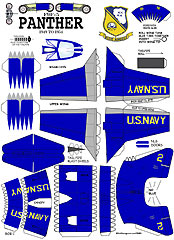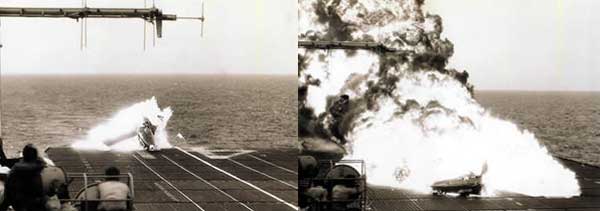



Grumman Panther - $$4.50
The Grumman F9F Panther was the manufacturer's first jet fighter and the U.S. Navy's second. The Panther was the most widely used U.S. Navy jet fighter of the Korean War. It flew 78,000 sorties and was responsible for the first air kill by the US Navy in the war—the downing of a North Korean Yakovlev Yak-9 fighter.
US Navy Grumman F9F Panther Carrier Based Jet


The F9F Panther brought the jet age to the US Navy. Although not the Navy's first carrier jet, it was the first to reach widespread service and to win real popularity among the Navy and Marine pilots who flew in it. There were reconnaissance and targetdrone Panthers too, but this superbly tough warplane is best remembered as the most important carrier-borne jet fighter of the Korean War.
The F9F Panther was the most successful of the first generation of us Navy jets. Originally proposed as a four-jet combat craft, which the Navy sensibly rejected, the single-engine Panther was a sturdy warplane which performed well but required nurturing over time.
Panthers flew in Navy squadrons with three choices of powerplant (J33, J42 and J48) before the Navy settled on the F9F-5 propelled by a J48, based on the Rolls-Royce Tay.
The Panther flew for the first time in 1947, and was the first carrier-based jet fighter to see combat. Extensively used on ground-attack duties in Korea, the Panther was a fine warplane in the hands of a trained pilot. Its structural strength, a trademark of the 'Grumman Iron works', helped Marines enormously when they flew Panthers through gunfire to attack ground troops in Korea.
But in spite of the fact that a Panther gained the US Navy's first jet kill, a MiG-15 in November 1950, the F9F was seriously outclassed by the swept-wing F-86 Sabre and MiG-15 which were entering service.
The last operational Panther was retired in October 1958, but the old fighter continued as a training machine and target tug well into the 1960s.
Great links to Panther info:
www.aircraft-list.com
Well I finally finished this model or at least have nearly finished it. I took a few pictures which I hope show the beauty of this particular aircraft. It is definitely one of my favorites! I've had a ball taking your original design and adding some of my own details to it like wing tanks, rockets, 20mm nose cannons, clear canopy, interior cockpit details and (as a coming attraction) bombs., CECIL , 11/00
Grumman F9F Panther
 The F9F-2 Panther Jet:
The F9F-2 Panther Jet: This was the first jet product from the 'Grumman Iron Works' and a healthy successor to the Hellcat and Bearcat. Used by both the U.S. Navy and the Marines, it saw action in Korea, scoring the odd kill. The later Cougar introduced an upgraded engine and swept wings.
Grumman's first jet fighter design began somewhat unconventionally, largely because early jet engine development under Navy sponsorship made a false start. One of the engines under development and available to Grumman designers in the closing days of the war was the 1,500 lb st. Westinghouse 130. and in order to obtain the required performance four of these engines were considered necessary in the original Grumman design, which was for a night fighter. A contract for this design, designated XF9F-1, was issued on April 22, 1946, but as the design progressed, doubts arose about the method of installing the four engines in the wings.
Consequently, Grumman decided to use a single engine located more conventionally in the fuselage, and turned to the imported Rolls-Royce Nene which was then rated at 5,000 lb s.t. The new design, for a day fighter, was designated XF9F-2, and the original contract was amended to cover two prototypes.
The first of two XF9F-2s flew on November 24, 1947, and a third prototype was flown on August 16, 1948, as the XF9F-3 with a 4,600 lb s.t. Allison 133-A-8; the latter engine was regarded as an alternative to the Nene, which Pratt & Whitney built under licence as the 142. Production contracts were placed initially for 47 F9F-2s with J42-P-6 engines and 54 F9F-3s with 133-A-8s, the Grumman cat' family being perpetuated with selection of the name Panther.
Production progressed simultaneously and both variants flew in November 1948, but the -2 proved superior, and 142 production proceeded on schedule, so the F9F-3s were converted to -2s and further contracts were placed to bring the total quantity to 437. First deliveries to an operational unit were made in May 1949, the receiving unit being VF-51. All production aircraft had permanent wingtip tanks, a feature not present on the prototypes.
Use of the Allison 133-A-C6 was planned in 73 F9F-4s, but these aircraft were absorbed in contracts for a total of 655 F9F-5s with the 6,250 lb s.t. J48-P-2, 148-P-4 or J48-P-6A engine. The F9F-5 (and the projected F9F-4) had a 2-ft fuselage extension and a taller fin. The first flew on December 21, 1949, and production included camera-equipped F9F-5Ps.
Flying off the USS Valley Forge, F9F-2s became the first Navy jet fighter ever used in combat when they went into action over Korea on July 3, 1950, and on November 9 the same year an F9F pilot became the Navy's first to shoot down a jet aircraft when he destroyed a MiG-15.
After being succeeded by swept wing developments of the same design, the straight-wing Panthers were adapted for special duties including the F9F-5KD which was equipped for use as a target drone or drone controller. The remaining examples in service in 1962 became DF-9Es.



 |
Grumman F9F Panther Cockpit. |
Specifications for the Grumman F9F-2 Panther
 |
Length: 37 ft 5 in Wingspan: 38 ft Height: 11 ft 4 in Wing area: 250 ft² Empty weight: 9,303 lb Loaded weight: 14,235 lb Max takeoff weight: 16,450 lb Powerplant: 1× Pratt & Whitney J42-P-6/P-8 turbojet, 5,950 lbf with water injection Performance Maximum speed: 575 mph Range: 1,300 mi Service ceiling: 44,600 ft Rate of climb: 5,140 ft/min Wing loading: 71 lb/ft² Thrust/weight: 0.42 Armament Guns: 4 × 20 mm (0.79 in) M2 cannon, 190 rpg Hardpoints: Underwing hardpoints and provisions to carry combinations of: Rockets: |6 × 5 in (127 mm) rockets on underwing hardpoints Bombs: 2,000 lbs of bombs |
 |
|||
| A: The 'panther's head' paint scheme was a personal badge. | B: The Panther suffered instability problems which were never entirely cured. | C: The deep, sturdy fuselage was so shaped because the J42 engine was of centrifugal design. | D: An Internal 25-gallon tank of water/methanol was fitted beneath the fin, to give extra engine thrust. |
| E: Four 20-mm cannon were mounted in the nose, which could be slid forward to gain access for reloading. | F: Panthers had two ventral airbrakes, mounted left and right on the front fuselage. | G: Although ostensibly a fighter, the Panther usually delivered air-to-ground munitions such as HVAR rockets or bombs. | H: The strong tail hook and high landing speed caused at least two Panthers to rip their tails off on landing. |
 |
George Duncan on the second test flight on June 23 1951, was coming in for his trap landing, he was lined up to catch the third wire, strung across the carrier's flight deck. But, without any warning, the descending Panther caught an air pocket, and dipped below the flight deck. Duncan pulled back on the stick, then saw nothing but flames! Duncan had managed to kick the nose of his plane upwards just as the plane smashed into the edge of the carrier's deck, splitting the jet in half. From behind the cockpit to the nose of the plane, the partial fuselage violently tumbled and rolled down the deck of the carrier, as the remaining chuck of the plane, and its fuel, ignited into a fireball and chased Duncan's cockpit down the deck.The force of the impact popped the canopy off of Duncan's cockpit, as well as his helmet. But amazingly, he was still strapped into his seat, and alive. Skidding to a stop, deck hands on the flight deck rushed to Duncan's aid, and pulled him from the fiery remains of his jet, and rushed him to the sickbay.
... deck hands ... rushed to Duncan's aid Duncan was burned by the fireball, and his ears were badly scorched, but he was otherwise unharmed by the crash. Several months later, Duncan was back flying. |


